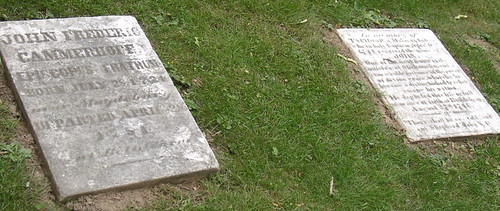All Saints' Day
There are people who find cemeteries uncomfortable. I am not one of those. They are hallowed ground, the locations of memory and grace and hope and sadness and grief. When we go to a cemetery we go to the place of the Saints. It is not a morbid fascination, nor is it a worship of the ancestors. But to visit the resting place of the ancestors can be a moving and spiritual experience.
In the early Moravian tradition in this country in Bethlehem, PA (above) and other places, all grave markers were flat. Every person, in death was equal with every other person. That later changed when some wanted to have more elaborate monuments than stones flat on the ground. Since these usually were people with more money and therefore "pull" the tradition passed. But not before leaving us with a special and faithful legacy.
In addition, families were also not buried together. The cemetery had different sections for men, women, and children. They were buried in the order of their deaths in the appropriate section. The picture above is of one of the places I find special and holy. Whenever I get to Bethlehem, PA, and can break away for even a short time I go to the old Moravian Cemetery and stop by this northwest corner of the graves.
On the left is the grave of Bishop Cammerhoff, one of the youngest bishops of the church. He died in his mid-30s. On the right is the grave of "John" a Mohican whose native name was Tschoop. Tschoop was the model for James Fenimore Cooper's Last of the Mohicans. In that early Moravian equality these two very different individuals are buried in equality, the equality of the saints in glory. On the other side of the Bishop is David Nitschmann, founder of the city of Bethlehem, and after John are other of his people.
This is for me the power of All Saints' Day. It is the power of life redeemed and an essential equality that no one should ever take away from us. Recent studies in science and genetics has shown that there is no such thing as different races. The major differences in genetic makeup are between individuals regardless of "race" or "ethnicity" than between different "races." All Saints' Day and my Moravian theological heritage keeps me aware of that at its very deepest level.
But All Saints' is also a day of remembrance. Which is why is Latino cultures, for example, the care given to graves at this time is so important. One of the great hymns of the church speaks to this which reminds me- and I hope all- that we are not the first nor last of the company of the Saints. We are simply the present caretakers.
Ten thousand times ten thousand in sparkling raiment bright,
The armies of the ransomed saints throng up the steeps of light;
’Tis finished, all is finished, their fight with death and sin;
Fling open wide the golden gates, and let the victors in.
What rush of alleluias fills all the earth and sky!
What ringing of a thousand harps bespeaks the triumph nigh!
O day, for which creation and all its tribes were made;
O joy, for all its former woes a thousandfold repaid!
O then what raptured greetings on Canaan’s happy shore;
What knitting severed friendships up, where partings are no more!
Then eyes with joy shall sparkle, that brimmed with tears of late;
Orphans no longer fatherless, nor widows desolate.
Bring near Thy great salvation, Thou Lamb for sinners slain;
Fill up the roll of Thine elect, then take Thy power, and reign;
Appear, Desire of nations, Thine exiles long for home;
Show in the heaven Thy promised sign; Thou Prince and Savior, come.



No comments:
Post a Comment